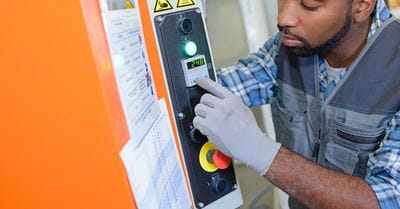Vertical Reciprocating Conveyors | Oxnard

Raymond West supplies warehouse automation equipment such as VRC's.
We are among the largest suppliers of warehouse automation equipment in the state.
Call us today at (805) 667-0888.
What Is a Vertical Reciprocating Conveyor (VRC)?
A vertical reciprocating conveyor is a safe, relatively inexpensive, convenient means to move materials from one level to another. VRCs have use case scenarios in many different industries, including factories, warehouses, distribution centers, and other multi-level buildings. These adaptable pieces of equipment may easily be integrated with a structure’s mezzanine, balcony, basement or any upper floor levels.
VRC’s are made up of a shaft, a cage, and a mechanical or hydraulic system. Vertical material lifts can be added almost anywhere on the interior or exterior of a structure. Gates and enclosures installed around VRC shafts keep workers safe and prevent accidents.
What Are Some Advantages of VRCs?
Safety: Many operations are dependent upon lift trucks for vertical movement of products. Although highly capable machines, forklifts are primarily designed for the horizontal movement of goods. In the name of efficiency, employees may sometimes extend their forklifts beyond their vertical limit or transport loads beyond their truck’s capacity rating. When these transgressions occur, the chances of a serious accident multiply.
For some vertical transport of goods between levels, VRCs provide a safe and efficient replacement for forklifts. Specifically designed and manufactured for each operation’s application demands, VRCs greatly diminish the chances of human error.
Additionally, VRCs are built to move heavier loads more frequently. These faster cycle rates mean less labor hours and lower costs. For companies that have routine vertical transport requirements, vertical reciprocating conveyors can enhance worker safety and decrease costs.
Customization: One significant advantage of VRCs is the extent to which they can be adapted to unique requirements. Because passenger elevators are designed to safely move humans, there are numerous regulations that limit the speed, capacity and size of these machines. Although such safety measures are appropriate for safely transporting humans, they are inhibitive for high volume movement of materials in production facilities, warehouses and distribution operations. Vertical lifts can be readily customized due to the fact that they are not bound by the same regulations as passenger lifts.
Regulation: VRCs are built to move goods only, while standard elevators are meant to move both people and materials. Due to this fundamental distinction, VRCs are exempt from the strict elevator regulations in many states.
In place of local jurisdiction, VRCs are regulated by their own universal code that is administered by the American Society of Mechanical Engineers (ASME), one of the preeminent standards shaping organizations in the country. More specifically, vertical reciprocating conveyors must comply with ASME’s Safety Standard for Conveyor and Related Equipment (ASME B20.1-2018). This standard defines the rules for the fabrication, installation, operating procedure and maintenance of conveyor systems.
Raymond West Is A Full Service Supplier of Vertical Reciprocating Conveyors
If you need to purchase a VRC, have questions or need engineering assistance, Raymond West can help. Our material handling experts can help plan, procure, install and service a system that’s suitable for your operation. Get in touch with us today!
Raymond West's Oxnard / Ventura service area includes Camarillo, Thousand Oaks, Moorpark, Newbury Park, Ventura, Santa Paula, Westlake Village, Simi Valley and all surrounding areas.
Raymond West | Oxnard Material Handling Equipment Supplier
Ventura County, CA
(805) 667-0888

